Published as part of the ECB Economic Bulletin, Issue 1/2023.
Work from home (WFH) patterns have changed substantially following the onset of the coronavirus (COVID-19) pandemic and point to a persistently higher preference for remote work. WFH was not particularly prevalent in the euro area before the onset of the pandemic in March 2020. According to Eurostat data, 85% of employees had never worked from home in 2019, a small decrease from 92% in 2000.[1] The COVID-19 shock led to a sudden increase in demand for WFH policies that would allow the majority of employees to work from home at least once per week.[2] This rise in WFH was enabled by investments made by both employers and workers. This box documents the changes in WFH during the pandemic and the main drivers behind them as well as future expectations for work preferences. Changes in WFH patterns and preferences potentially have important consequences for economic and social developments, including in the labour market and housing choices.[3]
The ECB Consumer Expectations Survey (CES) asked consumers about WFH at different points between 2020 and 2022.[4] According to CES data more than 60% of workers had never worked from home before the pandemic.[5] That share dropped to below 40% in the months following the start of the pandemic. In May 2022 the majority of workers in the euro area reported that they had worked remotely at least one day per week during the previous three months (Chart A). Most workers who worked remotely did so between two to four days per week. Workers were also asked about their preferences regarding WFH once the COVID-19 pandemic was over; around two-thirds indicated that they would like to work remotely at least one day per week and around 25% showed a preference for a WFH regime of between two to four days per week. These figures suggest a desire for hybrid working modes to prevail beyond the restrictions and health concerns related to the pandemic.[6]
Chart A
Number of WFH days before and during the COVID-19 pandemic and preferences for after
(percentage of respondents)
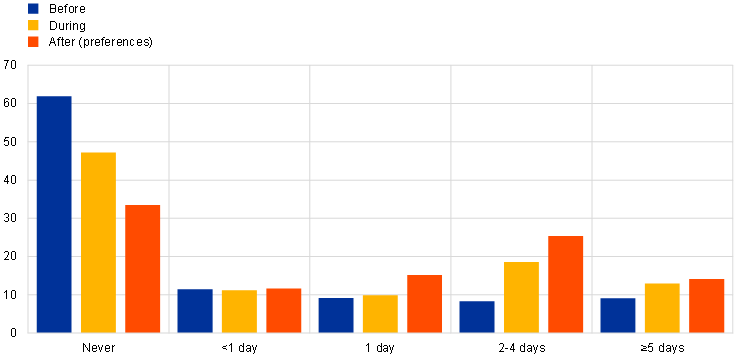
Source: ECB (CES, May 2022).
Note: Respondents (aged 20-64) were asked in May 2022 about (i) the number of WFH days available to them per week before the COVID-19 pandemic, (ii) the number of WFH days available to them in a typical month from February to April 2022 and (iii) their preferred number of WFH days per week after the COVID-19 pandemic ends.
On average, workers see their preferences for WFH as broadly aligned with the preferences they perceive their employers to have. In August 2021 around 40% of workers indicated that they would like to work from home at least two days per week after the pandemic and 27% expected their employer to offer this option (Chart B). 60% of workers believed that their preferences for WFH were aligned with those they perceived their employers to have. However, 30% of workers had WFH preferences that exceeded what they expected their employers to offer. There has therefore been some discussion as to whether this perceived gap might increase the willingness of some workers to switch employers, as having flexible work arrangements (including the possibility of working remotely) has been cited as an important motive for searching for a new job.[7]
Chart B
Workers’ WFH preferences and perception of their employers’ WFH preferences
(percentage of respondents)
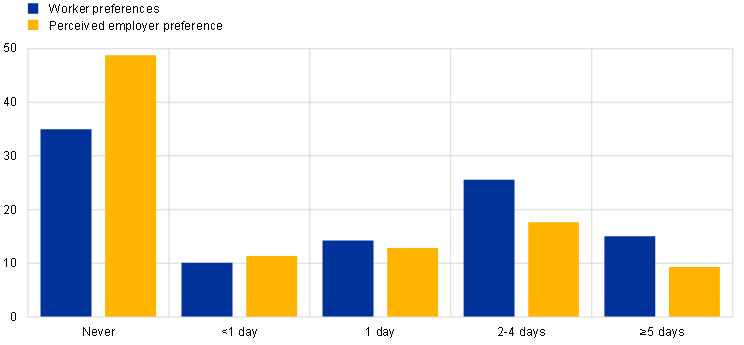
Source: ECB (CES, August 2021).
Notes: The chart shows workers’ preferred number of WFH days per week and their perception of their employers’ preferences. The data refer to workers aged 20-64.
The willingness of some workers to search for and switch jobs may be affected by the WFH policy they perceive their employers to be offering. The wider prevalence of WFH potentially increased the importance of WFH when choosing an employer. If a worker’s WFH preferences exceed what their current employer offers, this can lead to an increased willingness to change jobs. Accordingly, we found that workers with WFH preferences exceeding what they perceive their employers to be offering were more likely to search for new jobs and were more likely to have switched jobs at least once after the survey was conducted (Chart C).[8]
Chart C
WFH preferences and worker retainment
(percentage of respondents)
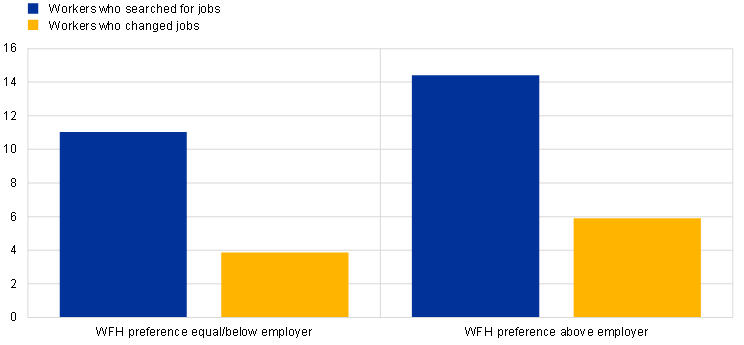
Source: ECB (CES, July 2021, August 2021 and following waves until May 2022).
Note: The chart shows the share of workers who had searched for a job prior to the survey date (August 2021) and the share of workers who changed jobs within the subsequent nine months by their WFH preference as reported in August 2021. The data refer to workers aged 20-64.
Workers’ preferred number of WFH days per month varied starkly in relation to job and personal characteristics.[9] Occupation is the most important factor in explaining WFH preferences. For example, clerical support workers prefer 4.5 WFH days per month more than plant or machine operators (Chart D). This suggests that job characteristics have a strong bearing on WFH preferences. It should be noted that the feasibility of completing work remotely – the “teleworkability” of a job – varies substantially across different occupations.[10] This is a constraint that is at least partially reflected in the WFH preferences indicated by workers in the survey. In the following, we therefore examine the personal characteristics that determine WFH preferences after accounting for limiting constraints such as occupation, sector and firm size.
Chart D
Number of preferred WFH days per month by occupation and teleworkability
(number of working days per month)
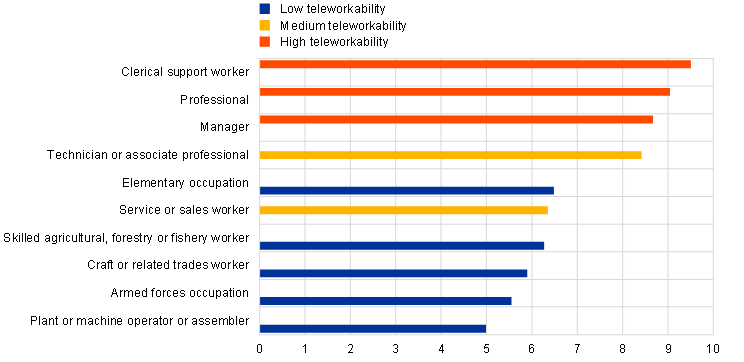
Source: ECB (CES, May 2022).
Notes: Estimation results of an OLS regression with the dependent variable being the number of working days per month that a worker wants to work from home (max. 20). We controlled for age, children in the household, gender, education, commute time, self-employment status, firm size, occupation, sector, and country. The data refer to workers aged 20-64. For the definition of teleworkability, see Sostero et al., “Teleworkability and the COVID-19 crisis: a new digital divide?”, JRC Working Paper Series on Labour, Education and Technology, European Commission, 2020.
Workers’ commute time is the most important personal characteristic determining WFH preferences. After controlling for job-specific characteristics, commute time is shown to be the most important person-specific driver of WFH preferences. While characteristics like occupation or sector are, to a large extent, linked to whether a specific job is able to be worked remotely, commute time often reflects a personal preference. Workers who commute more than one hour each way prefer ten WFH days per month, which is four days more than workers whose commute time is less than 15 minutes (Chart E). This is in line with previous findings for the United States which show that saved commute time is the most important benefit of WFH, particularly for women and higher-educated workers.[11] We also find that demographic characteristics play a role; younger people, women and households with children aged six or below indicate a preference for a higher number of WFH days per month. These associations are statistically significant but are quantitatively small.
Chart E
Preferred number of WFH days per month by commute time
(number of working days per month)
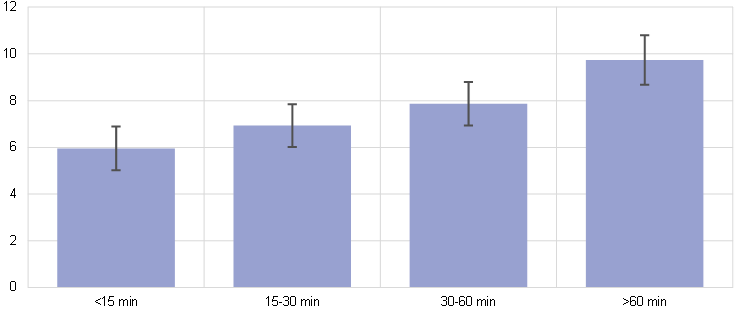
Source: ECB (CES, May 2022).
Note: Estimation results of an OLS regression with the dependent variable being the number of working days per month that a worker wants to work from home (max. 20). The coefficients are relative to workers who never commute. We controlled for age, children in the household, gender, education, self-employment status, firm size, occupation, sector and country. The data refer to workers aged 20-64.
Employers and workers are still adapting to changing WFH patterns brought about by the COVID-19 pandemic. However, it appears likely that remote work will remain in substantially higher demand than before the onset of the pandemic. Workers indicate a high preference for WFH, and a hybrid WFH pattern that offers between two and four days of remote work per week appears to be the preferred option for many. Our findings also suggest that WFH preferences may affect workers’ job search behaviour. Personal and job-specific characteristics are both important factors determining WFH preferences. In particular, workers with long commute times seem to strongly prefer remote work and may therefore be more willing to change jobs to find WFH conditions that fit their preferences.
This is in line with numbers from the United States that show 92.5% of all workers never worked from home in 2000, which decreased to90.5% in 2010 (See Mateyka P.J., Rapino M.A. and Landivar, L.C., “Home-Based Workers in the United States: 2010”, Home Economic Studies, U.S. Department of Commerce, Economics and Statistics Administration, U.S. Census Bureau, 2012).
See “Living, working and COVID-19: First findings – April 2020”, Covid-19 Series, Eurofound, 2020.
See, for example, Williamson, H., “An Evaluation of the Impacts of Remote Working”, Irish Government Economic and Evaluation Service Paper, Department of Enterprise, Trade and Employment, May 2022.
Some special-purpose questions were posed, asking consumers about how many days they worked from home before the pandemic and during the pandemic as well as their future preferences for the number of days they would like to work remotely. The analysis is based on responses from households in Belgium, Germany, Spain, France, Italy and the Netherlands.
Unlike Eurostat, the CES asked if respondents had worked from home before the onset of the COVID-19 pandemic, and not just during the last four weeks. This, in addition to the different sample of the CES, may explain why the share of workers without WFH experience is lower in the CES.
Preferences have been remarkably stable on aggregate. At all survey times throughout the COVID-19 period around 40% of respondents wanted to work at least two days remotely after the pandemic. However, this aggregate preference stability masks some change on an individual level; only around half of the workers who favoured at least two WFH days per week in August 2021 stated the same preference in May 2022.
See, for example, Americans are embracing flexible work – and they want more of it, McKinsey & Company, July 2022; or Barrero, J.M., Bloom, N. and Davis, S.J., “Let me work from home, or I will find another job”, VOX-EU, 27 July 2021.
The group of workers with WFH preferences equal to or below those they perceived their employers to have and the group with WFH preferences above those they perceived their employers to have are very similar in terms of their wage level, education, household income, age or duration in the panel dataset.
For this analysis we re-coded the bracketed preferences for weekly WFH days into monthly WFH days, taking the mid-point of the bracket.
See, for example, Dingel, J.I. and Neiman, B., “How many jobs can be done at home?”, Journal of Public Economics, Vol. 189, September 2020, pp. 1-8, and Bates, C. and Vivian L., “Teleworkable jobs”, Box 4 in “The impact of the COVID-19 pandemic on the euro area labour market”, Economic Bulletin, Issue 8, ECB, 2020.
Barrero, J.M., Bloom, N. and Davis, S.J., “SWAA March 2022 Updates”, WFH Research, March 2022; Barrero, J.M., Bloom, N. and Davis, S.J., “Why working from home will stick”, NBER Working Paper, No. 28731, National Bureau of Economic Research, April 2021.





